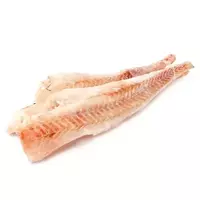Filet heka

We think not many domestic consumers know that the well-known hake fish is actually called Merluccius or Merluccius. This genus of fish belongs to the family of the same name and includes 11 species. Fish of hake or merlouse are common in the waters of the Atlantic, and in addition to the Pacific oceans. Usually, the hek lives at a depth of 100 to 1000 meters.
Depending on the variety, as well as the distribution range, the size of the hake fish can vary from 30 cm to
1. 5 meters. A characteristic feature of merlouse can be considered a silver-gray color, as well as a dark back of the fish. At its biological core, the fish heck is a predator that feeds on smaller fish. Often, the life expectancy of hake fish reaches 20 years.
Among the main important commercial species of hake fish, the following can be distinguished:
the European hake or merlusa lives in the eastern waters of the Atlantic Ocean, and is also found in the Black and Mediterranean Seas;
Silvery merlouse is common off the coast of North America; The Pacific merlusa or hake is found in the Pacific Ocean as well as the Berengov Sea;
Argentine hake are mined near the coast of South America;
Cape merlusa is considered an important object of fishing, the fish is distributed off the coast of South Africa, as well as Angola.
Hake fish is valued for its excellent taste, and in addition, consumer characteristics. Heka fillet is especially popular among culinary experts. Unlike a whole carcass, hake fillet does not contain bones, so the product is convenient to use in the preparation of various culinary products. As a rule, hake fillet is sold fresh frozen or fresh. In addition, frozen fish semi-finished products or fish burgers, as well as sticks, have recently become popular on the basis of hake fillet.
Hake fillet is subjected to various types of heat treatment, and fish mince is also produced. The chemical composition of hake fillet contains a number of naturally occurring compounds that are certainly useful for the human body. The calorie content of hake fillet can vary depending on the subspecies of the fish, as well as the habitat. However, the average calorie level of hake fillet is at 82 Kcal, which is per 100 grams of product.
Professional culinary experts especially appreciate hake fillet for its delicate taste. It is worth noting that although the hake fillet contains a small amount of fat, the product is superior in taste characteristics, for example, fish such as cod. Nutritionists, as well as doctors, recommend introducing hake fillet into the diet of people of all ages. Heka fillet refers to dietary and at the same time incredibly healthy foods that help in the prevention and treatment of diseases of the thyroid gland, as well as the gastrointestinal tract.
hake fillet 82.26 kCal
Energy value of hake fillet (Ratio of proteins, fats, carbohydrates - ju):
Squirrels: 16.54 (~ 66 kCal)
Fats: 1.84 g (~ 17 kCal)
Carbohydrates: 0 g (~ 0 kCal)
Energy ratio (b | y): 80% | 20% | 0%
 Español
Español Français
Français Português
Português Русский
Русский 简体中文
简体中文 繁體中文
繁體中文 日本語
日本語 한국어
한국어 العربية
العربية Türkçe
Türkçe Қазақ
Қазақ Deutsch
Deutsch Italiano
Italiano Українська
Українська
